Abstract
NAD(P)H-flavin oxidoreductases (flavin reductases) from luminous bacteria catalyze the reduction of flavin by NAD(P)H and are believed to provide the reduced form of flavin mononucleotide (FMN) for luciferase in the bioluminescence reaction. By using an oligonucleotide probe based on the partial N-terminal amino acid sequence of the Vibrio harveyi NADPH-FMN oxidoreductase (flavin reductase P), a recombinant plasmid, pFRP1, was obtained which contained the frp gene encoding this enzyme. The DNA sequence of the frp gene was determined; the deduced amino acid sequence for flavin reductase P consists of 240 amino acid residues with a molecular weight of 26,312. The frp gene was overexpressed, apparently through induction, in Escherichia coli JM109 cells harboring pFRP1. The cloned flavin reductase P was purified to homogeneity by following a new and simple procedure involving FMN-agarose chromatography as a key step. The same chromatography material was also highly effective in concentrating diluted flavin reductase P. The purified enzyme is a monomer and is unusual in having a tightly bound FMN cofactor. Distinct from the free FMN, the bound FMN cofactor showed a diminished A375 peak and a slightly increased 8-nm red-shifted A453 peak and was completely or nearly nonfluorescent. The Kms for FMN and NADPH and the turnover number of this flavin reductase were determined. In comparison with other flavin reductases and homologous proteins, this flavin reductase P shows a number of distinct features with respect to primary sequence, redox center, and/or kinetic mechanism.
Full text
PDF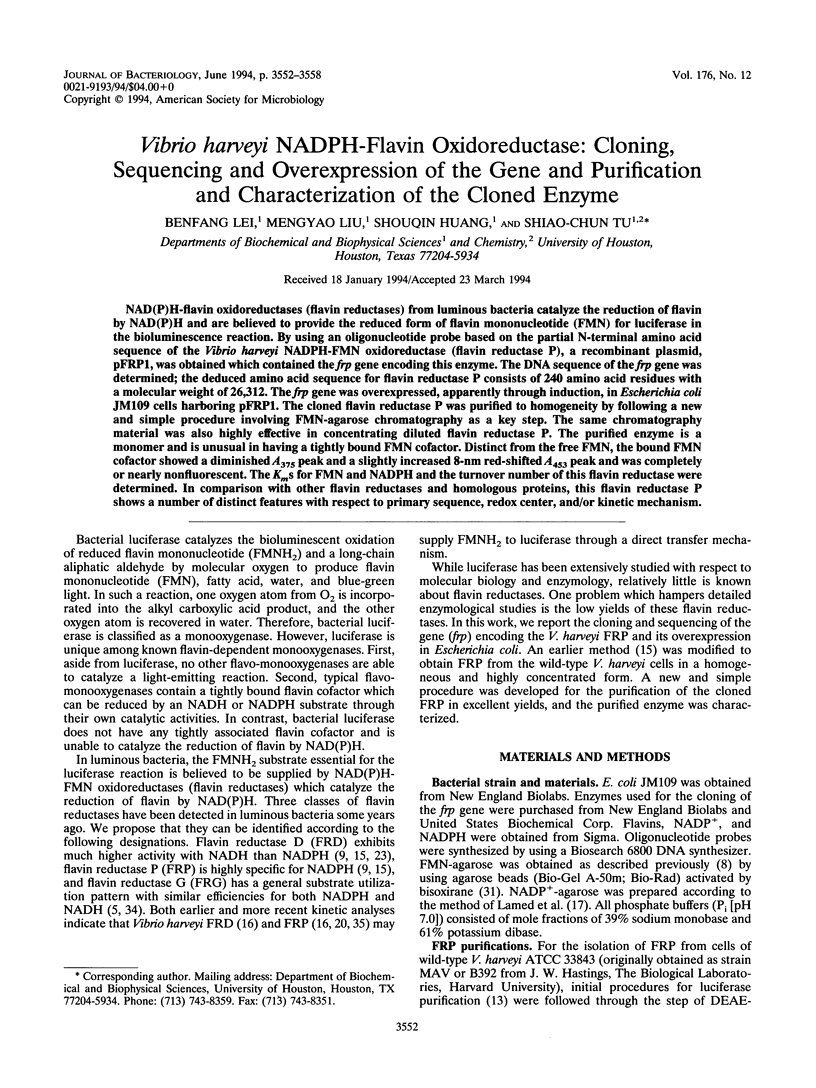
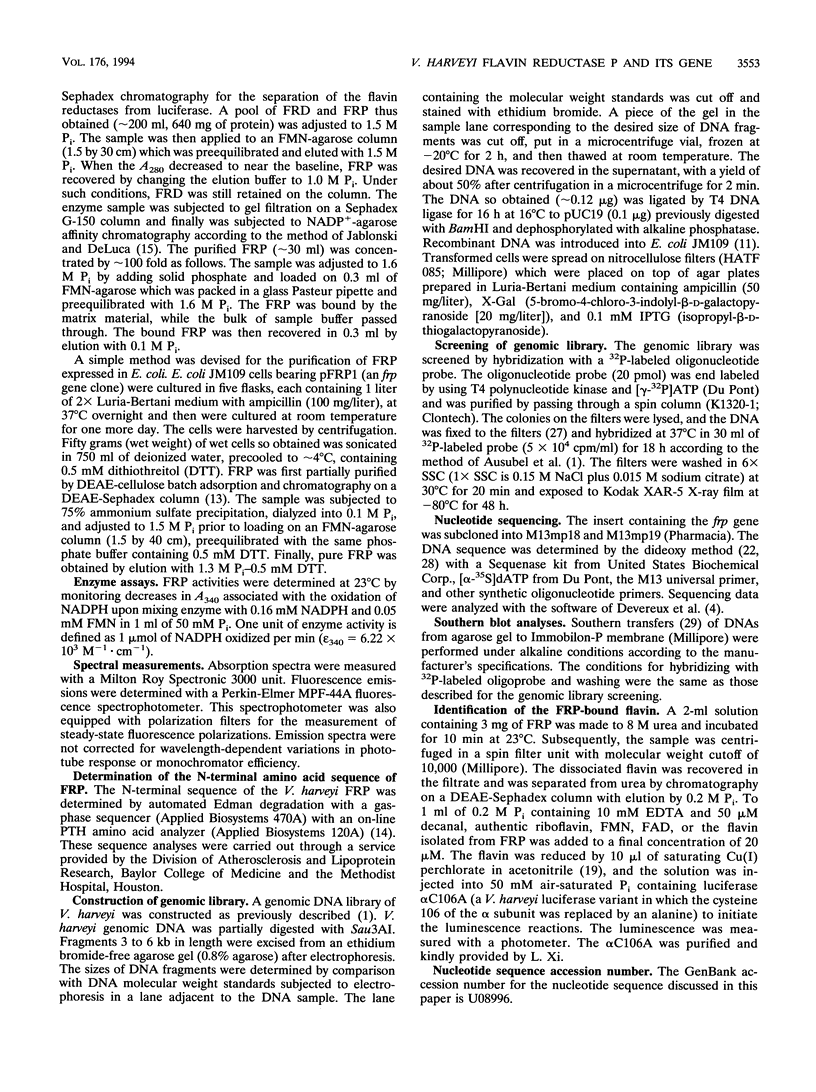

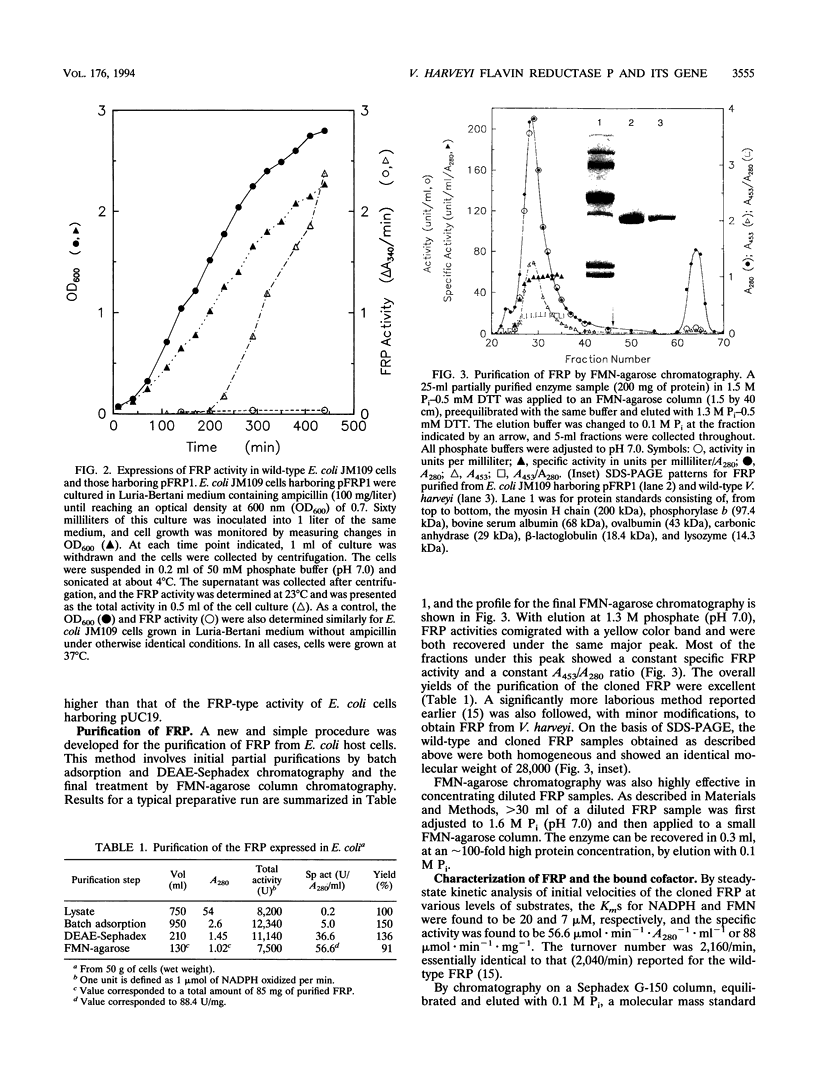
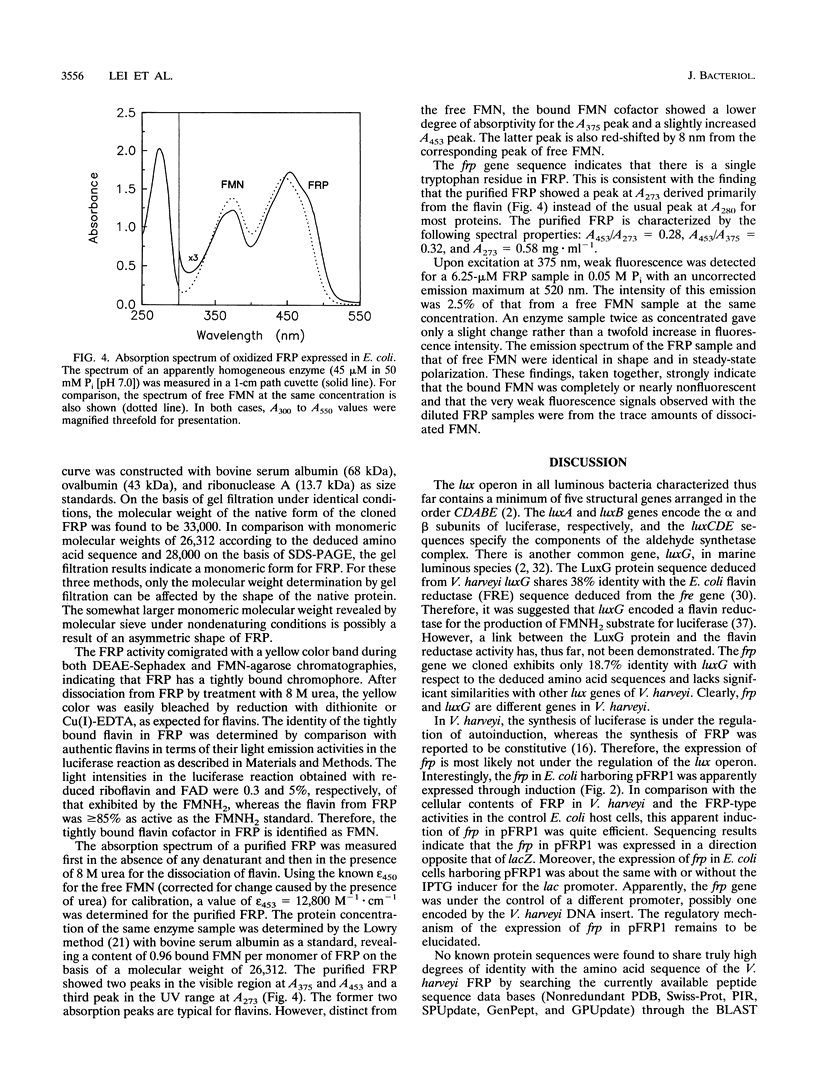
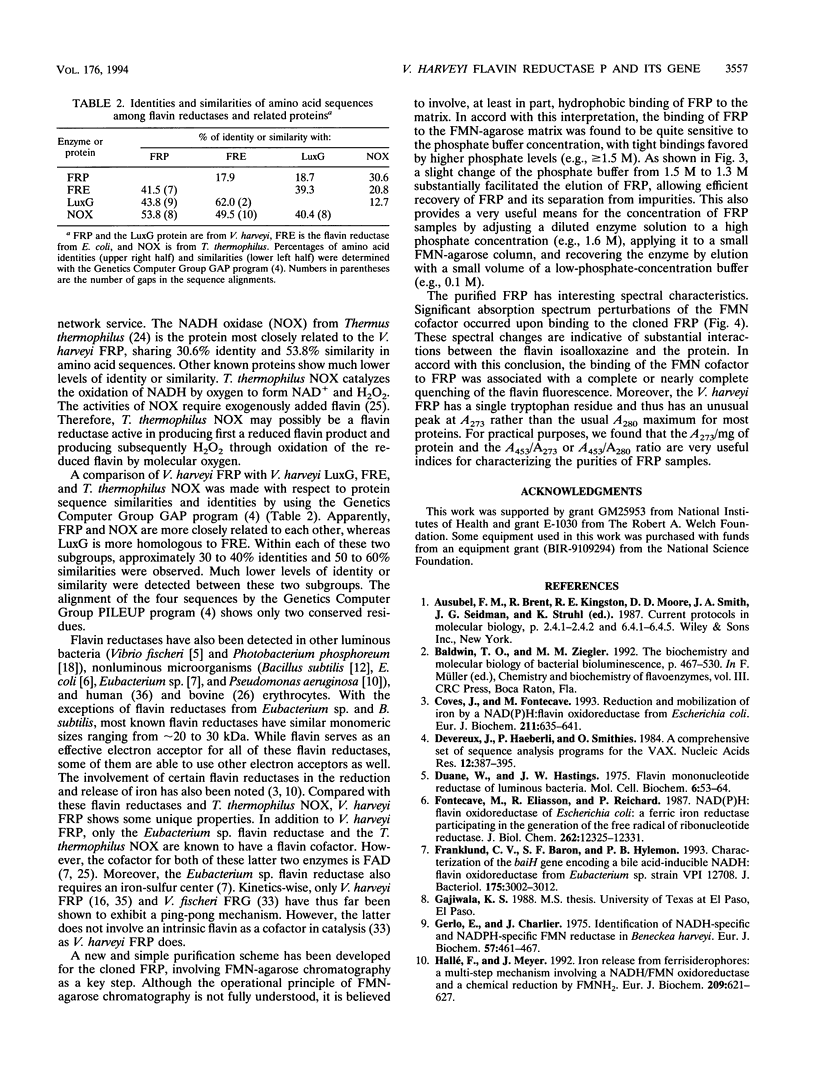
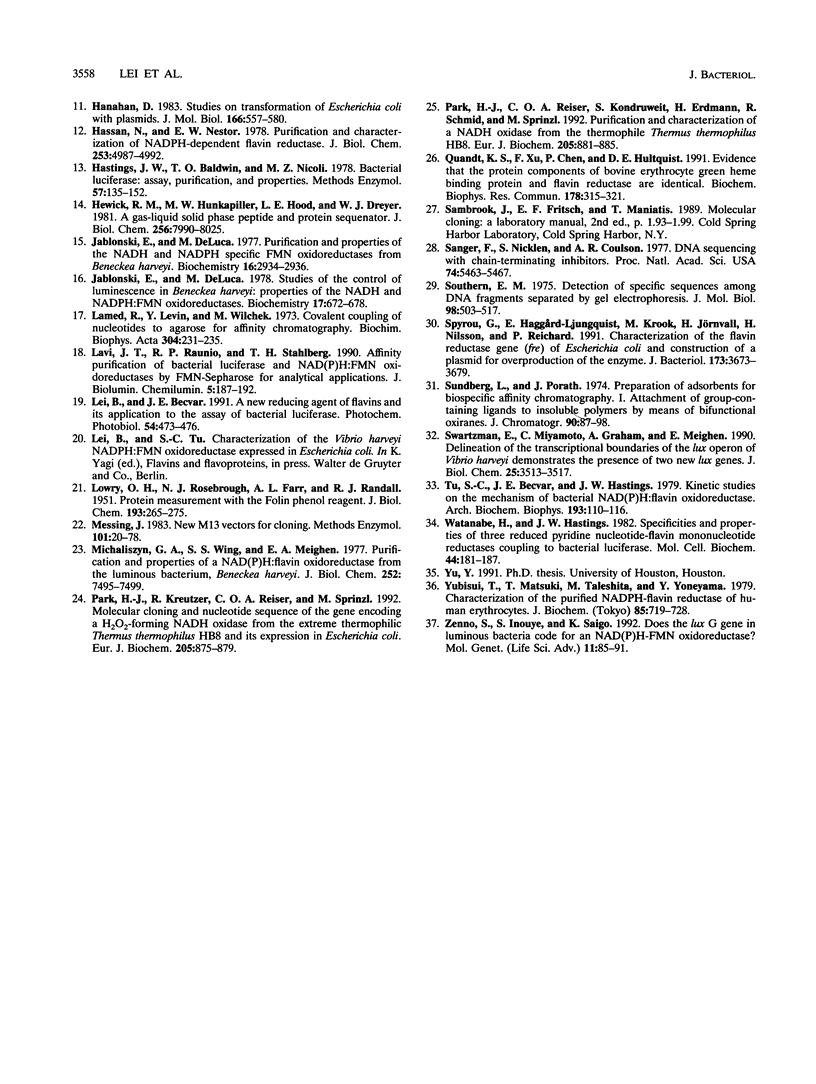
Images in this article
Selected References
These references are in PubMed. This may not be the complete list of references from this article.
- Coves J., Fontecave M. Reduction and mobilization of iron by a NAD(P)H:flavin oxidoreductase from Escherichia coli. Eur J Biochem. 1993 Feb 1;211(3):635–641. doi: 10.1111/j.1432-1033.1993.tb17591.x. [DOI] [PubMed] [Google Scholar]
- Devereux J., Haeberli P., Smithies O. A comprehensive set of sequence analysis programs for the VAX. Nucleic Acids Res. 1984 Jan 11;12(1 Pt 1):387–395. doi: 10.1093/nar/12.1part1.387. [DOI] [PMC free article] [PubMed] [Google Scholar]
- Duane W., Hastings J. W. Flavin mononucleotide reductase of luminous bacteria. Mol Cell Biochem. 1975 Jan 31;6(1):53–64. doi: 10.1007/BF01731866. [DOI] [PubMed] [Google Scholar]
- Fontecave M., Eliasson R., Reichard P. NAD(P)H:flavin oxidoreductase of Escherichia coli. A ferric iron reductase participating in the generation of the free radical of ribonucleotide reductase. J Biol Chem. 1987 Sep 5;262(25):12325–12331. [PubMed] [Google Scholar]
- Franklund C. V., Baron S. F., Hylemon P. B. Characterization of the baiH gene encoding a bile acid-inducible NADH:flavin oxidoreductase from Eubacterium sp. strain VPI 12708. J Bacteriol. 1993 May;175(10):3002–3012. doi: 10.1128/jb.175.10.3002-3012.1993. [DOI] [PMC free article] [PubMed] [Google Scholar]
- Gerlo E., Charlier J. Identification of NADH-specific and NADPH-specific FMN reductases in Beneckea harveyi. Eur J Biochem. 1975 Sep 15;57(2):461–467. doi: 10.1111/j.1432-1033.1975.tb02321.x. [DOI] [PubMed] [Google Scholar]
- Hallé F., Meyer J. M. Iron release from ferrisiderophores. A multi-step mechanism involving a NADH/FMN oxidoreductase and a chemical reduction by FMNH2. Eur J Biochem. 1992 Oct 15;209(2):621–627. doi: 10.1111/j.1432-1033.1992.tb17328.x. [DOI] [PubMed] [Google Scholar]
- Hanahan D. Studies on transformation of Escherichia coli with plasmids. J Mol Biol. 1983 Jun 5;166(4):557–580. doi: 10.1016/s0022-2836(83)80284-8. [DOI] [PubMed] [Google Scholar]
- Hasan N., Nester E. W. Purification and characterization of NADPH-dependent flavin reductase. An enzyme required for the activation of chorismate synthase in Bacillus subtilis. J Biol Chem. 1978 Jul 25;253(14):4987–4992. [PubMed] [Google Scholar]
- Hewick R. M., Hunkapiller M. W., Hood L. E., Dreyer W. J. A gas-liquid solid phase peptide and protein sequenator. J Biol Chem. 1981 Aug 10;256(15):7990–7997. [PubMed] [Google Scholar]
- Jablonski E., DeLuca M. Purification and properties of the NADH and NADPH specific FMN oxidoreductases from Beneckea harveyi. Biochemistry. 1977 Jun 28;16(13):2932–2936. doi: 10.1021/bi00632a020. [DOI] [PubMed] [Google Scholar]
- Jablonski E., DeLuca M. Studies of the control of luminescence in Beneckea harveyi: properties of the NADH and NADPH:FMN oxidoreductases. Biochemistry. 1978 Feb 21;17(4):672–678. doi: 10.1021/bi00597a018. [DOI] [PubMed] [Google Scholar]
- LOWRY O. H., ROSEBROUGH N. J., FARR A. L., RANDALL R. J. Protein measurement with the Folin phenol reagent. J Biol Chem. 1951 Nov;193(1):265–275. [PubMed] [Google Scholar]
- Lamed R., Levin Y., Wilchek M. Covalent coupling of nucleotides to agarose for affinity chromatography. Biochim Biophys Acta. 1973 Apr 28;304(2):231–235. doi: 10.1016/0304-4165(73)90239-0. [DOI] [PubMed] [Google Scholar]
- Lavi J. T., Raunio R. P., Stahlberg T. H. Affinity purification of bacterial luciferase and NAD(P)H:FMN oxidoreductases by FMN-sepharose for analytical applications. J Biolumin Chemilumin. 1990 Jul-Sep;5(3):187–192. doi: 10.1002/bio.1170050308. [DOI] [PubMed] [Google Scholar]
- Lei B. F., Becvar J. E. A new reducing agent of flavins and its application to the assay of bacterial luciferase. Photochem Photobiol. 1991 Sep;54(3):473–476. doi: 10.1111/j.1751-1097.1991.tb02043.x. [DOI] [PubMed] [Google Scholar]
- Messing J. New M13 vectors for cloning. Methods Enzymol. 1983;101:20–78. doi: 10.1016/0076-6879(83)01005-8. [DOI] [PubMed] [Google Scholar]
- Michaliszyn G. A., Wing S. S., Meighen E. A. Purification and properties of a NAD(P)H:flavin oxidoreductase from the luminous bacterium, Beneckea harveyi. J Biol Chem. 1977 Nov 10;252(21):7495–7499. [PubMed] [Google Scholar]
- Park H. J., Kreutzer R., Reiser C. O., Sprinzl M. Molecular cloning and nucleotide sequence of the gene encoding a H2O2-forming NADH oxidase from the extreme thermophilic Thermus thermophilus HB8 and its expression in Escherichia coli. Eur J Biochem. 1992 May 1;205(3):875–879. doi: 10.1111/j.1432-1033.1992.tb16852.x. [DOI] [PubMed] [Google Scholar]
- Park H. J., Reiser C. O., Kondruweit S., Erdmann H., Schmid R. D., Sprinzl M. Purification and characterization of a NADH oxidase from the thermophile Thermus thermophilus HB8. Eur J Biochem. 1992 May 1;205(3):881–885. doi: 10.1111/j.1432-1033.1992.tb16853.x. [DOI] [PubMed] [Google Scholar]
- Quandt K. S., Xu F., Chen P., Hultquist D. E. Evidence that the protein components of bovine erythrocyte green heme binding protein and flavin reductase are identical. Biochem Biophys Res Commun. 1991 Jul 15;178(1):315–321. doi: 10.1016/0006-291x(91)91816-u. [DOI] [PubMed] [Google Scholar]
- Sanger F., Nicklen S., Coulson A. R. DNA sequencing with chain-terminating inhibitors. Proc Natl Acad Sci U S A. 1977 Dec;74(12):5463–5467. doi: 10.1073/pnas.74.12.5463. [DOI] [PMC free article] [PubMed] [Google Scholar]
- Southern E. M. Detection of specific sequences among DNA fragments separated by gel electrophoresis. J Mol Biol. 1975 Nov 5;98(3):503–517. doi: 10.1016/s0022-2836(75)80083-0. [DOI] [PubMed] [Google Scholar]
- Spyrou G., Haggård-Ljungquist E., Krook M., Jörnvall H., Nilsson E., Reichard P. Characterization of the flavin reductase gene (fre) of Escherichia coli and construction of a plasmid for overproduction of the enzyme. J Bacteriol. 1991 Jun;173(12):3673–3679. doi: 10.1128/jb.173.12.3673-3679.1991. [DOI] [PMC free article] [PubMed] [Google Scholar]
- Sundberg L., Porath J. Preparation of adsorbents for biospecific affinity chromatography. Attachment of group-containing ligands to insoluble polymers by means of bifuctional oxiranes. J Chromatogr. 1974 Mar 13;90(1):87–98. doi: 10.1016/s0021-9673(01)94777-6. [DOI] [PubMed] [Google Scholar]
- Swartzman E., Miyamoto C., Graham A., Meighen E. Delineation of the transcriptional boundaries of the lux operon of Vibrio harveyi demonstrates the presence of two new lux genes. J Biol Chem. 1990 Feb 25;265(6):3513–3517. [PubMed] [Google Scholar]
- Tu S. C., Becvar J. E., Hastings J. W. Kinetic studies on the mechanism of bacterial NAD(P)H:flavin oxidoreductase. Arch Biochem Biophys. 1979 Mar;193(1):110–116. doi: 10.1016/0003-9861(79)90013-4. [DOI] [PubMed] [Google Scholar]
- Watanabe H., Hastings J. W. Specificities and properties of three reduced pyridine nucleotide-flavin mononucleotide reductases coupling to bacterial luciferase. Mol Cell Biochem. 1982 May 14;44(3):181–187. doi: 10.1007/BF00238506. [DOI] [PubMed] [Google Scholar]
- Yubisui T., Matsuki T., Takeshita M., Yoneyama Y. Characterization of the purified NADPH-flavin reductase of human erythrocytes. J Biochem. 1979 Mar;85(3):719–728. [PubMed] [Google Scholar]



